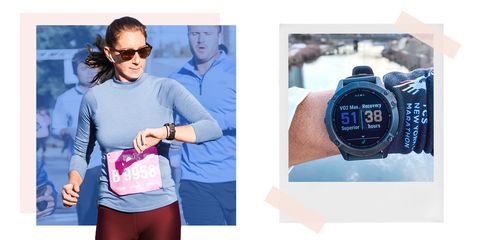There are a lot of cool things out there that make us wonder — do they really work? In our I Tried It series, we set out to use them in the real world and have determined that, in fact, they really do.
On Trial: Garmin Fenix 6
Tester: Ashley Mateo, a UESCA-certified running coach and six-time marathon finisher looking to PR in her next race
The Brief: Running purists will say you don’t need anything more than a classic Timex (if that!) to pace yourself during a run. I am not a purist.
I’ve run six marathons, all but one with my Apple Watch clocking my elapsed time, mileage, and pace. I loved the iPhone-esque display and the fact that I could get notifications (i.e. motivating texts) while I raced. But as I started prepping for my seventh marathon, with the hopes of setting another personal record, I decided I needed a watch that could do more than just tell me my current, rolling, or average pace. I wanted the best of the best. And that, people told me, is the Garmin Fenix 6.
I’ve been training with the Garmin Fenix for a month, and it’s already affected almost every aspect of my marathon training.
For starters, this training cycle is the first time I decided to work with a coach, someone whose prescribed specific speed- and heart-rate-based workouts to help me dial in my training. Each week, I program those specific workouts right into the Garmin app and sync them to my device.
Let’s say Monday calls for a speed workout with a 1-mile warmup, six 400-meter repeats at a fast pace with slower, 2-minute recovery periods in between, and a mile-long cool-down. Instead of having to watch the mileage on my watch while trying to maintain the right pace, the watch beeps to let me know when each segment begins and ends, and whether I’m running too fast or too slow according to the predetermined goals.
The watch uses optical heart-rate technology to gauge activity intensity. I’ve been using that feature specifically to work on my slower recovery runs — they’re just as important as speed workouts, but it’s really hard to slow yourself down when you just want to check a workout off your to-do list for the day. The heart-rate zones are clearly displayed on the face, so I can easily see if my intensity is too high for an easy run.
On race day, I plan to use the PacePro feature to stay on track. I tried it at a recent 10K run, setting my goal pace at 8:00, or a 49:42 finish time (it even gave me the option to choose my pacing strategy — i.e. start fast and allow for slowing down, or start slow and pick up speed throughout — and adjusted my predicted paces based on that). Throughout the race, my watch displayed my target pace for the current mile and how my current pace stacked up to that target; at the end of each mile, it provided an updated average pace I needed to maintain, depending on how far ahead or behind my goal pace I was, in order for me to hit my goal finish time. I ended up with an 8-minute PR thanks in part to the fact that I could see exactly where I stood the entire time instead of wasting energy doing that math in my head.
Even when I’m not actually running, the watch tracks a whole bunch of factors that can help my running performance. One I’ve been following closely is my VO2 max. This is the defining measure of cardiorespiratory fitness and aerobic performance capacity — and a major factor in marathon performance. The fitter you get, the more your VO2 max increases. But a decrease in VO2 max can mean you’re overtraining.
Recently, my legs were feeling like lead and I had an overall sense of fatigue that didn’t make sense. I noticed that my VO2 max was trending down, so I gave myself a 2-day break — and when I hit the road again, my VO2 max jumped back up.
After I log an activity, there’s also a recovery-time countdown I can check — right now, after running 21 miles over the past three days, it’s telling me I need 38 hours of recovery (that doesn’t mean no working out, but any activity should be pretty easy). I don’t blindly follow the watch’s advice, choosing instead to stick to my coach’s plan — but it’s something I use for planning what time of day to do my workouts and something I look to if I’m feeling a little off and want an explanation. And throughout each day, I can check my Body Battery, which tracks heart-rate variability, stress, sleep, and other data to gauge when you’re ready to be active or when you may need to rest.
I’ve been using this watch for a month and there are still a ton of features I’m learning about, like the Performance Condition tracker, a real-time assessment of your current ability to perform; the race time prediction (based on my current fitness stats, my watch says I could run a 42:07 10K — another 5-minute PR over what I ran just 2 weeks ago!); training effect, or how each training session is expected to impact your future fitness levels; and training load, or the combined strain of all your activities. And that’s not even mentioning the non-running features, like the animated workouts, backcountry skiing metrics, and 41,000 golf course maps.
Closing Argument: You certainly don’t need a watch to learn how to run faster and smarter. You don’t need a super fancy watch, either — there are a ton of affordable, accurate fitness watches out there. But if you’re a data nerd and you really love learning about how your training is affecting your body, the Garmin Fenix 6 provides endless metrics for you to really dig into. No PRs are guaranteed, but you’ll certainly get a better sense of your fitness level, which can only boost your performance!
Read more:
The Best GPS Watches to Map Out Your Runs
Hit New Health & Fitness Goals With These Awesome Products
Running Socks That Won't Give You Blisters






















